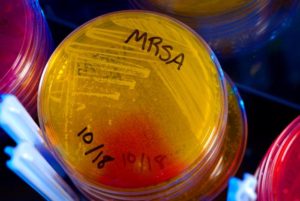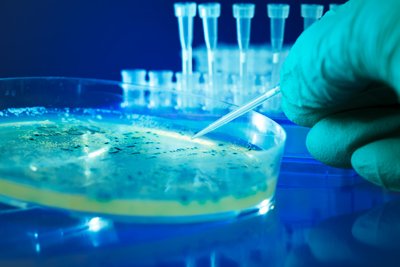A new family of antibiotics could help knock down drug-resistant bacteria, according to a study done in mice.
![]()
![]()
 The new group of antibiotic compounds were able to kill particular cells of methicillin-resistant Staphylococcus aureus (MRSA) that are usually unaffected by common forms of antibiotics. With antimicrobial resistance an increasingly serious threat to global public health, it’s hoped the study will aid the development of new antibiotics.
The new group of antibiotic compounds were able to kill particular cells of methicillin-resistant Staphylococcus aureus (MRSA) that are usually unaffected by common forms of antibiotics. With antimicrobial resistance an increasingly serious threat to global public health, it’s hoped the study will aid the development of new antibiotics.
Associate Professor Siouxsie Wiles, microbiologist, University of Auckland, comments:
“In their paper, Wooseong Kim and colleagues describe what could one day turn into a new class of antibiotics, which is exciting news given the catastrophic future we face due to antibiotic-resistant ‘superbugs’. The researchers have shown that their experimental antibiotics may prove useful for treating infections caused by the ‘superbug’ methicillin-resistant Staphylococcus aureus, more commonly known as MRSA. This is good news for us here in Aotearoa New Zealand, as our rates of S. aureus disease are amongst the highest in the developed world.
“But let’s not get too excited just yet. While the press release leads with the claim that the new compounds can kill MRSA in infected mice, a closer look at the actual data shows that this claim might not quite mean what people think it means. The antibiotics reduced the number of MRSA in the mice from about 1 billion to 50 million, which is still plenty of bacteria!
“What stands out to me about the study is the elegant way the researchers identified the new compounds – infecting microscopic worms with MRSA and then adding compounds to see if any of them helped the worms survive being infected. It also shows the scale of the work being done around the world to try to identify new classes of antibiotics. These researchers tested 82,000 compounds, identifying 185 that looked promising. From those came the two compounds they describe in this work. Now it’s fingers crossed those compounds can be improved upon so they can beat the odds and make it through animal and human trials and into the clinic. And even if they do, MRSA is just one of the superbugs that threaten to bring about the end of modern medicine as we know it.”
No conflict of interest.
Prof Kurt Krause, University of Otago Biochemist and Infectious Diseases Specialist, Webster Centre for Infectious Diseases, comments:
“Methicillin-Resistant Staphylococcus aureus (MRSA) is a pathogenic bacterium of major clinical importance, and is a worldwide cause of large numbers of serious infections each year. Vancomycin remains the mainstay antibiotic in use for these infections. But with the continual risk of the development of more Vancomycin Insensitive Staphylococcus aureus coupled with an increased global spread of antimicrobial resistance, new drugs against staph and other Gram-positive pathogens are badly needed. The letter by Kim et al. in this week’s issue of Nature, announces the development of a new class of antimicrobial compound which has strong anti-MRSA properties.
“The reported compounds are retinoids, analogues of Vitamin A, that work by membrane disruption. They were found by screening a compound library using an intriguing C. elegans (nematode) model of MRSA infection. The compounds they report, CD437 and CD1530, are effective against actively dividing MRSA as well as slow-growing persister populations that can be very challenging to treat.
“These two retinoid compounds also show synergy with gentamicin, which is important because gentamicin is often used in the dual therapy of serious staph infections. When used as monotherapy their activity in a mouse deep thigh model of infection was modest, unless coupled with gentamicin.
“The main concern about these two new compounds is the same as that for current retinoids in clinical use, cytotoxicity, which for these compounds was not insignificant. The good news is that Kim et al. also reported the discovery of a new analogue compound with much-reduced cell toxicity but which retained strong anti-MRSA activity. However, much more work on drug optimisation, as well as animal and other pre-clinical and clinical studies would be needed before these compounds would have the potential to see clinical use.”
No conflict of interest.
Dr Heather Hendrickson, Senior Lecturer in Molecular Bioscience, Massey University:
“The new paper from Kim and colleagues takes some nice steps towards measuring the effectiveness of an often overlooked class of potential antimicrobials against Methicillin-Resistant Staphylococcus aureus (MRSA).
“They started with a massive screen of small synthetic molecules (over 82,000 of them) and came up with 185 candidates that allowed tiny worms called Caenorhabditis elegans to survive when they were in the presence of infectious MRSA bacteria. In the initial test, if the worms lived, the well was dark. But if the worms had died, the well they had been put in would light up with a fluorescent stain. The scale and simplicity of this screen was impressive and powerful.
“They focussed on a pair of man-made compounds that are structurally related to vitamin A called synthetic retinoids. In order to learn how the molecules work, they looked at how the molecules reacted to bacterial membranes in computer simulations and found that they disrupt the membranes.
“Membranes are an interesting target for antibacterial compounds because they act as both the battery, or power source, and the boundary of these cells and are hard for bacteria to fix through mutation. This may be part of the reason that when the authors evolved the bacteria in the presence of the retinoid molecules, MRSA and other similar bacteria did not evolve resistance easily. This is good news.
“Some of the most troubling bacterial cells in an infection are those that are in a semi-resting state and are therefore not killed or affected by normal antibiotics. The researchers tested their molecules against this group of bacteria, called ‘persisters’, and found that the retinoid could dramatically reduce the numbers of these persister cells within four hours.
“These antibiotic molecules are not ready for the big time yet, but the authors make a point of noting that even though some similar molecules are toxic, it is worth looking into this sort of action towards the membranes of the bacterial cells for antimicrobials. They have the potential to be effective, especially when combined with other antibiotics like gentamycin. The degree to which the bacteria remained susceptible to the retinoids, even after a long period of exposure, was also very promising.
“MRSA did not easily evolve worrying levels of resistance to these retinoids and that is an important feature in the hunt for new antimicrobials.”
Heather is not involved in the research in this study and does not have any other conflicts of interest with respect to this work.
